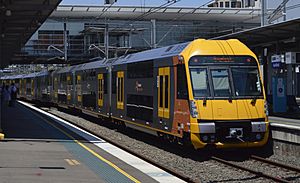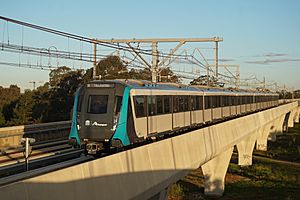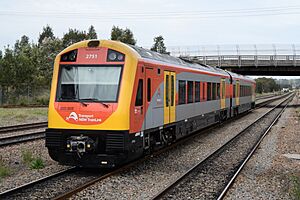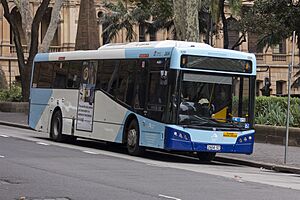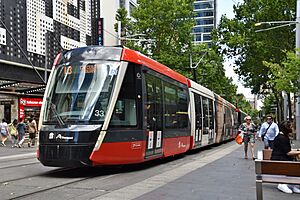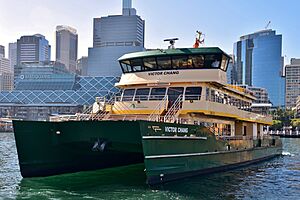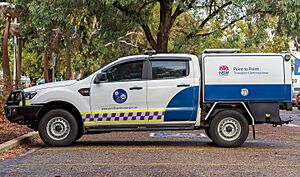Transport for NSW facts for kids
 |
|
| Agency overview | |
|---|---|
| Formed | 1 November 2011 |
| Preceding agencies |
|
| Type | Statutory authority |
| Jurisdiction | New South Wales |
| Headquarters | 231 Elizabeth Street, Sydney |
| Employees | 28,790 (June 2022) |
| Annual budget | $28.8 billion (2022) |
| Ministers responsible | |
| Agency executive |
|
| Parent Agency | New South Wales Department of Transport |
| Website | www.transport.nsw.gov.au |
Transport for NSW (TfNSW) is a government agency in New South Wales (NSW), Australia. It was created on 1 November 2011. TfNSW helps manage transport services and roads across the state. It is part of the larger NSW Department of Transport.
TfNSW builds new transport systems and looks after existing ones. This includes trains, buses, ferries, and light rail. Since 2019, it also manages roads. This means building and maintaining roads. It also handles vehicle and driving license registrations. TfNSW works to make sure transport is safe and follows rules.
The agency reports to several ministers in the NSW government. These ministers are responsible for transport, roads, and regional transport. They answer to the Parliament of New South Wales.
Contents
How Transport for NSW Started
Early Transport Management
Before TfNSW, different government groups managed transport in NSW. These groups changed names and responsibilities over many years. For example, there were departments for railways, main roads, and motor transport. They all worked to keep people and goods moving.
Creating Transport for NSW
In November 2011, the NSW government created Transport for NSW. This new agency brought many transport functions together. It took over planning and coordination from other groups. These included RailCorp, the State Transit Authority, and Roads & Maritime Services. TfNSW also took on roles from Sydney Metro Authority. This made it easier to plan and manage all transport.
Ferry Services in Sydney
TfNSW manages the ferry services in Sydney Harbour. It hires companies like Harbour City Ferries and Transdev Sydney Ferries to run the boats. However, TfNSW still owns the ferry boats themselves. It also owns the Balmain shipyard where ferries are maintained.
Light Rail and Monorail Changes
In 2012, TfNSW bought the company that owned Sydney's Light Rail and Monorail. The Monorail was closed in 2013. The Light Rail system was then directly managed by TfNSW. This was part of a plan to improve public transport.
New Train Agencies
In 2013, the jobs of running trains were split into new agencies. Sydney Trains now runs suburban trains in Sydney. NSW TrainLink handles longer-distance trains and coaches. These new agencies work under Transport for NSW. They replaced older train services like CityRail and CountryLink.
In 2017, Sydney Trains and NSW Trains became independent agencies. They report directly to TfNSW. In 2018, Sydney Metro also became its own agency. It focuses on new, fast metro train lines.
Joining Roads and Transport
In December 2019, Roads & Maritime Services (RMS) joined Transport for NSW. This merger brought roads and transport under one agency. The goal was to make travel smoother. Now, one agency handles both roads and public transport.
Managing Parklands
Since April 2022, TfNSW also manages some major parklands in Sydney. This includes places like Centennial Parklands and Western Sydney Parklands. It also manages the Royal Botanic Gardens. This helps connect green spaces with transport planning.
What Transport for NSW Does
TfNSW creates rules and plans for transport. It makes sure transport is high quality and meets community needs. It also protects public money and the environment. The agency manages a huge budget for transport. It oversees over A$106 billion in transport assets. This includes money for trains, buses, ferries, and roads. TfNSW also funds programs like school transport help.
How Transport for NSW is Organized
TfNSW has different teams that handle specific jobs. Some teams focus on customer experience. Others plan new transport projects. There are also teams for freight and regional transport. Safety and rules are also managed by dedicated teams.
Key Transport Groups
The NSW Department of Transport includes several important groups:
- Transport Service of New South Wales: This group hires staff for TfNSW and other transport agencies.
- Transport for NSW: This is the main agency that plans and manages transport.
Under Transport for NSW, there are several key operating agencies:
- Sydney Ferries: Manages ferry services.
- State Transit Authority (STA): Operates some bus services.
- Sydney Trains: Runs suburban train services.
- NSW Trains: Manages regional trains and coaches.
- Sydney Metro: Oversees the new metro train lines.
Transport Leaders
The main leader of Transport for NSW is called the Secretary. This person helps manage all the different parts of the agency. The current Secretary is Josh Murray.
Ministers in Charge
Several ministers in the NSW government are responsible for transport. They make big decisions about how transport is run.
- The Minister for Transport (currently Jo Haylen)
- The Minister for Roads (currently John Graham)
- The Minister for Regional Transport and Roads (currently Jenny Aitchison)
These ministers are accountable to the NSW Parliament.
Public Transport Services
TfNSW directly manages most public transport in NSW. This includes trains, buses, ferries, and light rail. They design routes and create timetables. They also provide information to passengers. This information is available online and by phone. Private companies often operate the services.
Public transport services in NSW are simply branded as Transport. There are different names for each type of service:
- Sydney Metro: Fast train services in Sydney.
- Sydney Trains: Suburban train services in Sydney.
- NSW TrainLink: Long-distance trains and coaches across NSW. These also go to other states.
- Buses: Bus services in Sydney and other major areas.
- Sydney Ferries: Ferry services in Sydney.
- Sydney Light Rail: Light rail services in Sydney.
- Newcastle Transport: Bus, ferry, and light rail in Newcastle.
Many people use public transport in NSW. In 2017-18, there were 765 million journeys. Train use in Sydney increased by over 10% in that period.
Getting Transport Information
TfNSW offers a trip planner on its website, transportnsw.info. You can also call their 24-hour information line, 131 500. These services help you plan your journey. There is also a special service for people with hearing or speech difficulties.
Transport Infrastructure Projects
TfNSW works on many projects to improve transport. This includes building new lines and upgrading existing ones.
Public Transport Projects
Current Projects
| Project | Type of Transport | Expected Finish |
|---|---|---|
| Parramatta Light Rail | Light rail | 2024 |
| Sydney Metro City & Southwest | Rapid transit | 2024 |
| Sydney Metro West | Rapid transit | 2032 |
| Sydney Metro – Western Sydney Airport | Rapid transit | 2026 (for airport opening) |
| Automatic Train Protection Systems | Commuter rail | Ongoing |
| Transport Access Program | Public transport stops | Ongoing |
| More Trains More Services | Commuter rail | Ongoing |
Completed Projects
| Project | Type of Transport | Finished Date |
|---|---|---|
| Kingsgrove to Revesby quadruplication | Suburban rail | April 2013 |
| Liverpool Turnback | Suburban rail | January 2014 |
| Lilyfield – Dulwich Hill Light Rail Extension | Light rail | March 2014 |
| Monorail Removal Project | Monorail | April 2014 |
| Opal Card rollout | Electronic ticketing | December 2014 |
| South West Rail Link | Suburban rail | February 2015 |
| Newcastle Light Rail | Light rail | February 2019 |
| Sydney Metro Northwest | Rapid transit | May 2019 |
| CBD and South East Light Rail (L2 Randwick Line) | Light rail | December 2019 |
| CBD and South East Light Rail (L3 Kingsford Line) | Light rail | April 2020 |
Road Projects
TfNSW also manages many road building projects. Some of these were started by Roads & Maritime Services.
Current Road Projects
| Project | What it does | Expected Finish |
|---|---|---|
| Princes Highway upgrade | Making the highway wider with four lanes | Ongoing |
| WestConnex | Major motorway network in Sydney | 2023 |
| Sydney Gateway | Connects roads to Sydney Airport | 2024 |
| Western Harbour Tunnel | New tunnel under Sydney Harbour | 2026 to 2028 |
| M12 Motorway | New motorway for Western Sydney Airport | 2026 (for airport opening) |
Completed Road Projects
| Project | What it does | Finished Date |
|---|---|---|
| NorthConnex | New tunnel in northern Sydney | 31 October 2020 |
| Pacific Highway upgrade | Making the highway wider with four lanes | December 2020 |


